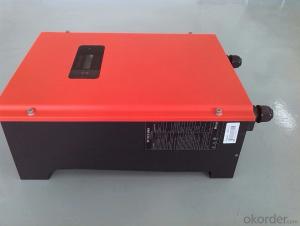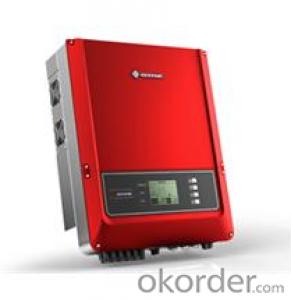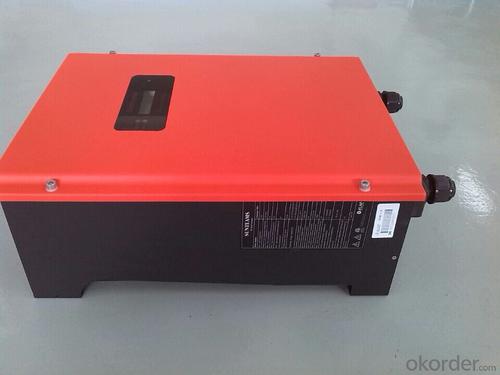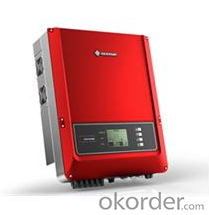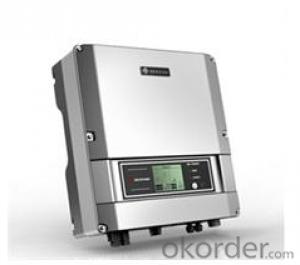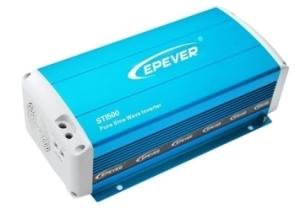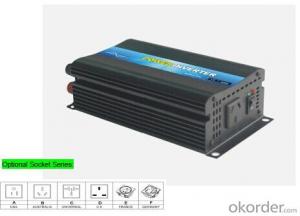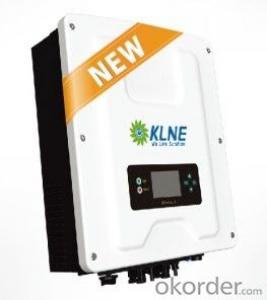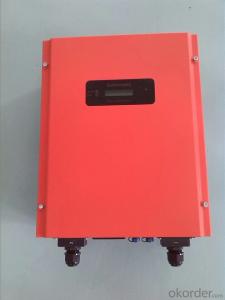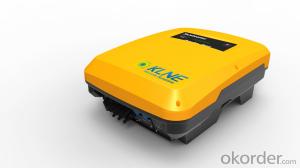Samsung Solar Inverter Off-Grid Type Solartec D 6000/8000
- Loading Port:
- Shanghai
- Payment Terms:
- TT OR LC
- Min Order Qty:
- 10 unit
- Supply Capability:
- 1000 unit/month
OKorder Service Pledge
OKorder Financial Service
You Might Also Like
Product Description:
The photovoltaic grid-connected inverter series of Solartec D 6 - 8 kW are applicable to all types of commercial rooftop projects or grid-connected power plant systems. The nominal output powers of this series are 6 kW and 8 kW respectively.
This series of inverters has 2 string MPP trackers and three level technology. These features ensure the high utilization rate of grid and maximize the system efficiency. The new technology of this series supports the adjustable power factor and grid monitoring, complies to German BDEW medium voltage guidelines and reaches European and Australian certification standards .
Efficient
■ Maximum efficiency 98 %
■ Flexible tracking with two MPP trackers
Reliable
■ Integrated DC switch
■ Three phase grid connection
■ Reliability and long life ensured by film capacitors
Flexible
■ DC input voltage up to 1,000 V
■ Reactive power supply
■ For indoor and outdoor installation
Communicative
■ RS232 / RS485 interfaces as standard
Product Datasheet:
Solartec D 6000 | Solartec D 8000 | |
Input Data | ||
Max. DC Power | 6350 W | 8250 W |
Max. DC Voltage | 1000 V | 1000 V |
System Start-up Voltage | 250 V | 250 V |
Full Load Voltage Range MPPT | 250 V - 800 V | 250 V - 800 V |
Max. Input Current | 2 × 16A | 2 × 16A |
Nominal DC Voltage | 650 V | 650 V |
Number of MPP Trackers | 2 | 2 |
Strings of each MPPT | A : 1, B : 1 | A : 1, B : 1 |
Output Data | ||
Nominal AC Output | 6000 W | 8000 W |
THD of AC Current | < 3.0 % | < 3.0 % |
Nominal Grid Voltage Range | 230 V - 400 V (3/N/PE) | 230 V - 400 V (3/N/PE) |
Nominal Grid Frequency | 50 Hz | 50 Hz |
Adjustable Displacement Factor | 0.9 overexcited...0.9 underexcited | 0.9 overexcited...0.9 underexcited |
Max. Output Current | 10 A | 13 A |
Efficiency |
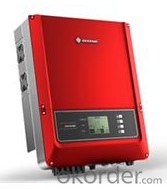
Product Advantages:
Powered by DC current
Can used out of doors
High effiency and low noise
FAQ
What is your payment terms?
We accept T/T payment, normally we need 20% T/T in advance, 80% payed before shipment.
What is your packing system?
We put the sistem in the wooden box.
Can you do OEM service?
Yes we can, but we need to do it with a certain order quantity.
- Q: What is the role of a solar inverter in voltage support?
- The role of a solar inverter in voltage support is to convert the direct current (DC) power generated by solar panels into alternating current (AC) power that can be used to support the voltage requirements of electrical devices and the overall electrical grid. The inverter ensures that the AC power produced by solar panels matches the voltage and frequency requirements of the electrical system, thereby providing stable and reliable power supply.
- Q: Can a solar inverter be installed outdoors?
- Yes, a solar inverter can be installed outdoors. However, it is important to ensure that the inverter is designed to withstand outdoor conditions, such as rain, humidity, and temperature fluctuations. Outdoor installation should also comply with local electrical codes and regulations.
- Q: What is the role of a reactive power controller in a solar inverter?
- The role of a reactive power controller in a solar inverter is to regulate and maintain the power factor of the inverter output. It ensures that the reactive power generated by the solar panels is properly balanced with the active power, thereby optimizing the efficiency and stability of the solar power system.
- Q: Can a solar inverter be used with different grid voltages or frequencies?
- No, a solar inverter cannot be used with different grid voltages or frequencies. Solar inverters are designed to convert the DC power generated by solar panels into AC power that matches the specific voltage and frequency of the local electrical grid. Using a solar inverter with different grid voltages or frequencies can lead to compatibility issues and may result in inefficient or malfunctioning operation of the system.
- Q: What is the difference between an on-grid and off-grid solar inverter?
- An on-grid solar inverter is designed to convert the DC power produced by solar panels into AC power that can be fed directly into the electrical grid. It synchronizes with the grid and adjusts the power output accordingly. In contrast, an off-grid solar inverter is used in standalone solar power systems that are not connected to the grid. It stores excess power in batteries and converts DC power to AC power for use in the off-grid system.
- Q: What are the communication protocols used in solar inverters?
- Solar inverters commonly use several communication protocols to enable communication with other devices or systems. Some of the most frequently employed communication protocols in solar inverters include: 1. Modbus: Modbus is an extensively utilized communication protocol for industrial devices, including solar inverters. It facilitates the transmission of data between the inverter and other devices, such as monitoring systems or data loggers. Modbus is well-regarded for its simplicity and flexibility, which contribute to its popularity in the solar industry. 2. SunSpec: SunSpec is a communication protocol specifically designed for the solar industry. It establishes a standardized means for solar inverters to communicate with other devices, such as smart meters or monitoring systems. SunSpec supports both wired and wireless communication, allowing for effortless integration of solar inverters into larger energy management systems. 3. CAN bus: CAN (Controller Area Network) bus is a widely employed communication protocol in various industries, including automotive and industrial applications. It is a robust and reliable protocol that enables high-speed communication between devices. Some solar inverters employ CAN bus to communicate with other devices or systems, ensuring a dependable means of data transfer. 4. Ethernet: Ethernet is a prevalent communication protocol in the IT industry and is also utilized in certain solar inverters. By utilizing Ethernet, solar inverters can communicate with other devices or systems over a local area network (LAN) or the internet. Ethernet offers high-speed communication and can accommodate various communication standards, making it a versatile option for solar inverters. It is essential to note that different solar inverter manufacturers may employ different communication protocols or a combination thereof. The selection of a communication protocol depends on factors such as the specific requirements of the system, compatibility with other devices or systems, and the desired level of integration.
- Q: Can a solar inverter be used with dual MPPT inputs?
- Yes, a solar inverter can be used with dual MPPT (Maximum Power Point Tracking) inputs. This feature allows the inverter to optimize and extract maximum power from two separate solar arrays or panels. By using dual MPPT inputs, the inverter can handle variations in shading, orientation, or different panel specifications, thereby maximizing the overall energy production and efficiency of the solar system.
- Q: Can a solar inverter be connected to a home automation system?
- Yes, a solar inverter can be connected to a home automation system. This integration allows homeowners to monitor and control their solar power generation and consumption remotely through their home automation system. It provides real-time data on energy production, allows for scheduling and optimizing energy usage, and enables the automation of various appliances and devices based on solar power availability.
- Q: Can a solar inverter be used with micro-inverters?
- Yes, a solar inverter can be used with micro-inverters. In fact, it is a common practice to combine a central solar inverter with micro-inverters in a solar system. The central inverter is responsible for converting the direct current (DC) power generated by the solar panels into alternating current (AC) power, while the micro-inverters optimize the power output of each individual solar panel. This combination allows for increased efficiency and flexibility in managing the solar system.
- Q: Can a solar inverter be used in areas with limited roof space or installation options?
- Indeed, areas with limited roof space or installation options can still make use of a solar inverter. Typically, solar inverters are compact, enabling installation in diverse locations like the ground, walls, or even indoors. Moreover, there are various types of solar inverters accessible, such as microinverters and power optimizers, which offer greater flexibility in system design and installation. By utilizing these alternatives, available space can be maximized, and more installation options can be provided for areas with restricted roof space.
Send your message to us
Samsung Solar Inverter Off-Grid Type Solartec D 6000/8000
- Loading Port:
- Shanghai
- Payment Terms:
- TT OR LC
- Min Order Qty:
- 10 unit
- Supply Capability:
- 1000 unit/month
OKorder Service Pledge
OKorder Financial Service
Similar products
Hot products
Hot Searches
Related keywords
